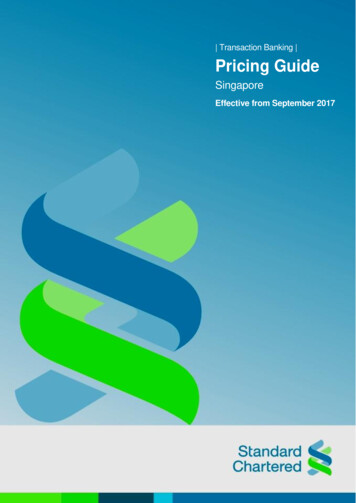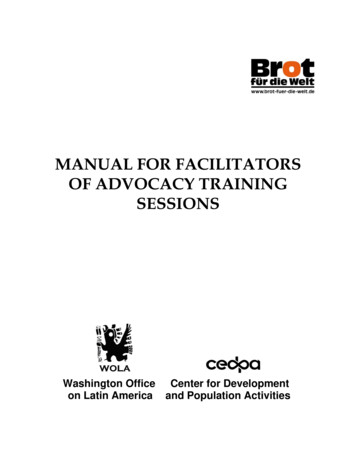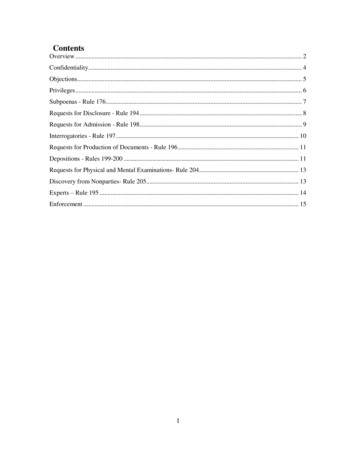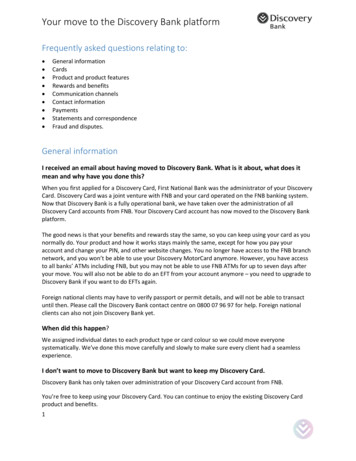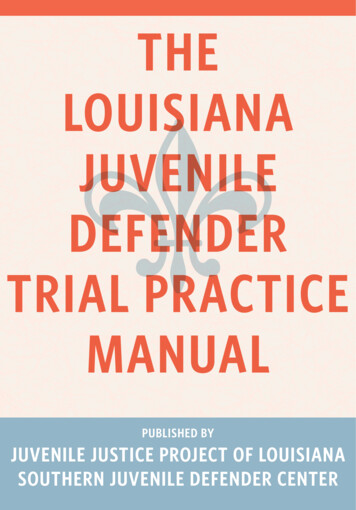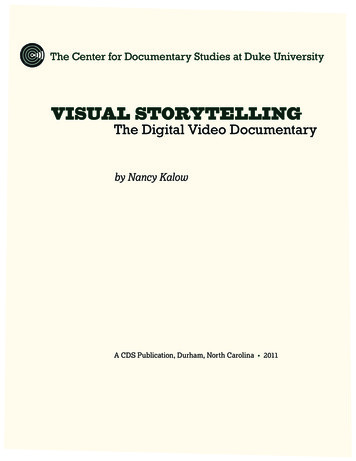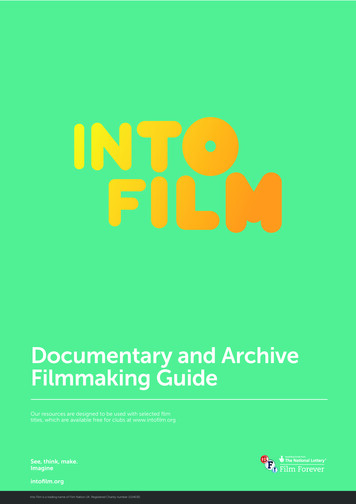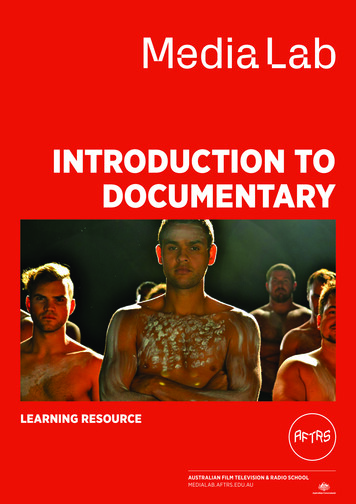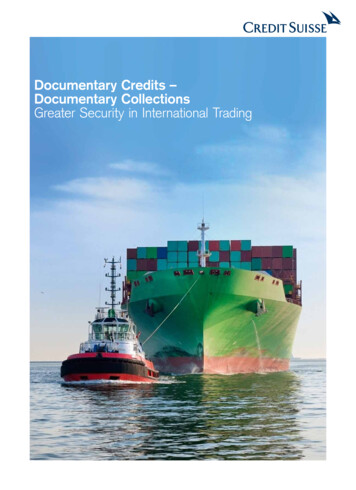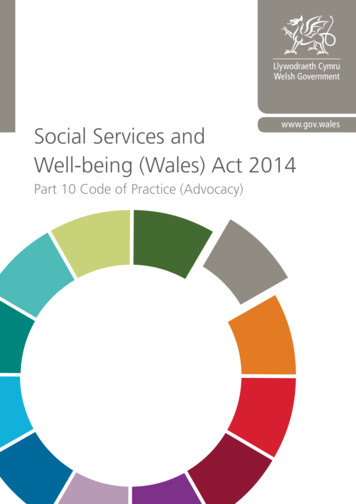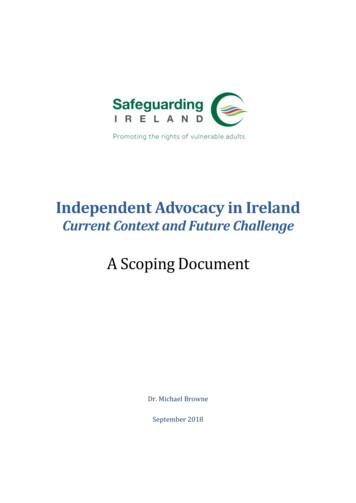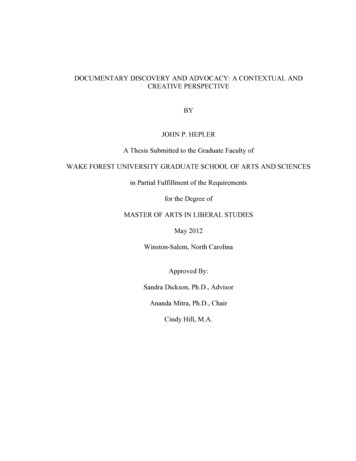
Transcription
DOCUMENTARY DISCOVERY AND ADVOCACY: A CONTEXTUAL ANDCREATIVE PERSPECTIVEBYJOHN P. HEPLERA Thesis Submitted to the Graduate Faculty ofWAKE FOREST UNIVERSITY GRADUATE SCHOOL OF ARTS AND SCIENCESin Partial Fulfillment of the Requirementsfor the Degree ofMASTER OF ARTS IN LIBERAL STUDIESMay 2012Winston-Salem, North CarolinaApproved By:Sandra Dickson, Ph.D., AdvisorAnanda Mitra, Ph.D., ChairCindy Hill, M.A.
ACKNOWLEDGMENTSI would like to commend Dr. Sandy Dickson for serving as my advisor on thisthesis project. Her guidance, suggestions of resources, and project planning assistance areinvaluable.I would also like to thank Drs. Dickson, Ananda Mitra and Eric Wilson alongwith Professors Cindy Hill and Steve Jarrett for teaching courses that inspired anddeepened my interest in film, literature, technology and film. I am grateful for the variousmaterials loaned and recommendations made as well as the feedback and advice they allso willingly gave.ii
ABSTRACTJohn P. HeplerDOCUMENTARY DISCOVERY AND ADVOCACY: A CONTEXTUAL ANDCREATIVE PERSPECTIVEThe thesis project described in this abstract fulfills the requirements for a masterof arts in liberal studies. The project consists of two required components: an originalcreation and a contextual analysis to inform the creation. The purpose of the originalcreation, a documentary short film, is twofold: to gain introductory experience in filmproduction as well as to lay the groundwork for a more professional subsequent film. Thedocumentary short introduces the world of medical research trials as well as thechallenging relationship between medical academia and pharmaceutical companies. Thefilmmaker's point of view is that drug manufacturers can potentially influence scientificfindings to increase profit.The contextual analysis highlights the subgenre of advocacy documentaries, muchlike the original documentary short described in this abstract, and examines the film’sstrategies and impact potential. The analysis informs the project by identifying provenstrategies for social change such as partnering with experts to hone the narrative as wellas enhancing the filmmaker's understanding of public consciousness concerning the issue.The nuanced subject matter of the documentary short is not widely recognized orunderstood. With the understanding that social reform is unlikely, the goal of this initialproject is to simply bring awareness and clarity to a little known topic in an engagingmanner. The short will then be used as a means to solicit funding and engage nonprofitpartners, as outlined in the contextual analysis, for a potential feature-length film andoutreach efforts.iii
TABLE OF CONTENTSPageACKNOWLEDGMENTS .iiABSTRACT . .iiiTABLE OF CONTENTS . .ivLIST OF ILLUSTRATIONS . .vCHAPTER1 Introduction . .12 Documentary Evolution . .53 Community Engagement . .94 Case Studies .215 Documentary Short . .276 Conclusion . .34WORKS CITED . .35CURRICULUM VITAE . .37iv
LIST OF ILLUSTRATIONSPageFIGURE 1Overall Effectiveness: CBS Documentary Research Unit 14FIGURE 2Dimensions of Impact: The Fledgling Fund .17FIGURE 3Ripple Effect: The Harmony Institute . 18v
CHAPTER 1INTRODUCTIONDocumentary film has a long and robust history anchored in an effort todisseminate, on regional, national, and international scales, "truth" concerning topics ofpublic interest. Not all nonfiction films have an ultimate goal of direct social change,because the subgenres of this category systemically range from poetic and expository toperformative and participatory (Nichols 99). Empirical measures regarding the efficacyand social impact of catalytic documentary film have been elusive because concreteevidence is difficult to appropriate and quantify. Early efforts in the 1940’s by ColumbiaBroadcasting System (CBS) Documentary Research Unit attempted to gaugedocumentary film impact by using panel interviews before and after broadcasts. “For thefunction of such broadcasts is to inform, clarify, and impart ideas and each documentaryis produced in the knowledge that its success will be measured by these yardsticks”(Wilson,19).More recently, nonprofit organizations and enterprises have acknowledged theexpanding need for formulating a methodology to measure the impact of advocacysubgenre films on society, politics, and business. Some of these include, but are notlimited to, Harmony Institute, Lexalytics, the Ford Foundation, the Wolfensohn FamilyFoundation, the Pacific Foundation, and the Fledgling Fund. Methodologies vary acrossthese organizations and will be examined in greater detail in the section pertaining tomeasuring narrative effect.1
In line with progress related to effectiveness, the evolution of broadcasting mediachanges the possibilities of social interactivity, impact and subsequent social reform. Theroots for broadcasting began in radio and then grew into television, which led to limitlesspossibilities for reaching attentive and international audiences using audiovisualprograms. Throughout most of the twentieth century, the medium of television concretelydefined the rules by which documentary film was funded, created, and distributed. Astechnological advances introduced the World Wide Web, personal computers, mobiledevices, and the ability to deliver digital video virtually for free, the production anddistribution model for documentaries began to change. This variability impacts not onlyhow films are produced and distributed, but also how potential viewers are engaged andequipped to take practical action as it relates to the subject matter. One example oftechnology transforming engagement is webdocs or microdocs, which are shortdocumentaries aimed predominantly at the mobile platform. Filmmakers are able tomarket their film more directly via the Internet and form strategic partnerships with othersources and sponsors. The Internet also fosters educational outreach by engaging strategicpartners who create content around issues linked directly to films posing questions toaudiences who will want to learn more.As with all advances, there are caveats. Technology not only streamlines andexpands the distribution model for documentaries, but also allows for a more far-reachingaudience and shrinks production cost. Technology also makes more individuals potentialfilmmakers regardless of the fundamental disciplines of effective writing,cinematography and directing. The end product is simply a greater quantity withpotentially inferior quality material. Through the onslaught of commercial advertisements,2
news feeds, social media, and instant information on virtually everything, mediainundation incubates social empathy and self-selectivity. This phenomenon furtherminimizes the impact of conventionally powerful films because they get lost in the blurof the media and noise. Self-selectivity also parallels the problem of viewershipaccessibility. According to Dr. Patricia Aufderheide, “It can be frustratingly hard forviewers to find even award-winning and critically praised public affairs and social-issuedocumentaries after a brief airing on television or at film festivals” (5).The question then is how do filmmakers get the necessary exposure for theirsocial documentary in a way that will engage audiences and motivate societal change.One potential avenue is through partnering with nonprofit organizations that can helpwith film direction and distribution. Partnerships should be a mutually beneficialrelationship: the documentary can help clarify and give voice to the nonprofit cause witha “creative treatment of actuality” (Grierson 12) and the nonprofit can contribute withexposure, networking, and potential funding, and message direction.Documentary case studies can show how various production techniques,directorial styles, nonprofit partnering, and audience engagement have worked well insome cases, and not so well in others. Socially conscious advocacy films such as JudithHelfand’s Blue Vinyl and Davis Guggenheim’s Waiting for “Superman” were created toinform audiences of potential wrongs as well as to stimulate change, which they both did.In comparison to advocacy films are participatory oriented films such as MichaelMoore’s Fahrenheit 9/11, where a predisposed position is promoted to guide the viewers’perception of contemporaneous events, leaving them questioning the validity of theevidence presented. Moore ends his film with a direct call to viewers to join his effort but3
leaves them uncertain as to specifics. Ambiguity in this type of film creates furthermisperception and polarization on its subject matter, which is debatably the opposite ofthe capital “T” truth that documentarians assert to disseminate.The final section of this paper profiles the thesis project’s accompanyingdocumentary short film as well as film script describing the author’s structural andaesthetic approach as filmmaker. The short introduces the domain of medical researchtrials and examines the challenging, and sometimes unbalanced, relationship betweenmedical academia and pharmaceutical companies. The filmmaker's point of view is thatdrug manufacturers can potentially influence scientific findings by exploiting inherentweaknesses in the trial design and process: for example, limited size and duration ofresearch, problematic detection of rare, late, or unexpected adverse events; selectivity ofparticipants, and research sponsors with fundamental conflicts of interest. Manipulationof any of these weaknesses can potentially result in the emphasis of drug benefit andsuppression of undesired drug safety data, creating public health concerns.Story strategy and production structure are informed by the analysis addressed inthis paper concerning effective partnering with experts, selection of distribution models,understanding of the documentary genre and audience proclivity, and framing of thefilmmaker’s claims to truth.4
CHAPTER 2DOCUMENTARY EVOLUTIONDocumentary film was instituted for the purpose of instructing and maintaininghistorical record and was shot on heavy, expensive cameras using equally expensive filmstock. Although innovative in nature, early film was limited in scope to showing a singleshot event, or “actuality,” such as a train entering a station or factory workers leaving forthe day, and was typically less than a minute in length. Soon thereafter, medical doctorssuch as French surgeon Eugéne-Louis Doyen and Romanian neurologist GheorgheMarinescu adopted this burgeoning media to not only document medical practices butalso to correct errors performed during various procedures.Advances in the early part of the twentieth century made travel more possible andfostered interest in foreign societies and culture, giving rise to travelogue or “scenic”,films. An early notable example is the 1909 Moscow Clad in Snow, a four-part filmintroducing Russia to domestic audiences. A contemporary comparison would perhaps bethe BBC productions Planet Earth and Planet Blue. A particular film that highlights thetransitional nature of this era, as well as audience perception, is In the Land of the HeadHunter (1914). This film presents itself under the pretense of a scenic that reveals theprimitive and exotic world of Native Americans. What the audience does not know is thatthe “actual” events are essentially staged re-enactments. The celebrated filmmaker RobertJ. Flaherty furthered this association of romanticism and documentary with his filmsNanook of the North (1922) and Moana (1926), both of which were heavily staged toshow how subjects once lived rather than how they were currently living. Films of this5
nature have more recently been categorized as “docufiction’” a neologism referring to thecinematographic combination of documentary and fiction.Shortly thereafter, romanticism gave birth to politically based propaganda films,made with the explicit purpose of persuading an audience of a particular point of view.One of the most notorious examples is Leni Riefenstahl’s Triumph of the Will (1935),which was commissioned by Adolf Hitler to chronicle the 1934 Nazi Party Congress andConvention. Within the same time frame, American films were being created thatsupported Franklin Delano Roosevelt’s New Deal included Pare Lorentz’s The Plow ThatBroke the Plains (1936), and The River (1938) and Willard Van Dyke’s The City (1939).These productions presented not only governmental propaganda but also multifacetedaspects of social and ecological awareness, a topic of deeper examination in forthcomingsections. Under similar governmental motives, the Canadian Film Board was founded byJohn Grierson to create psychological warfare pieces countering enemy propaganda. InGreat Britain, Grierson, together with several notable filmmakers formed what wasultimately known as the Documentary Film Movement, which blended propaganda,factual material, and education with a more expressive and appealing approach todocumentary. Films involved the amalgamation of various media such as literature,poetry, and music into a more comprehensive cinematic experience. Some of the bestknown films of the undertaking are Coal Face (1935) and Night Mail (1936).A similar contemporaneous challenge in marrying various resources for greaterimpact occurs with merging diverse strategies including nonprofit partnering,technological distribution and proven documentary storytelling to once again create aricher film experience. Documentary film continued to evolve through the combination6
and exploration of disciplines leading to the next developmental stage, called cinemaverité. Although different in respect to filmmaker involvement, cinema-verité is alsoreferred to as direct cinema or cinema direct in the United States and is a style thatincludes following a person during high-tension moments with a portable camera tocapture more intimate reactions. Until this time, this could not be done because of heavyequipment, which was always anchored to fixed structures. In cinema-verité, accidentaland spontaneous filming results in high volume of footage, or shooting ratios, giving theeditor freedom to discover and sculpt the story from within the footage rather than at thetime of capture. In many ways cinema-verité can also be seen as a reaction against studioproduction restrictions, which excluded independent filmmakers from taking advantageof promising technologies such as lightweight cameras and on-location sound syncing.Documentary film is ever evolving by employing proven principles andtechniques as well as determined innovation to create an abundance of nonfiction worksranging in style, form, and purpose. Because of documentary film's continual expansion,it is necessary to divide the genre into subgenres.American film critic and theoretician Bill Nichols defined six modes ofdocumentary from which the subgenre of socially conscious films develop and intersect.The first is the poetic mode, which is a transformation of historical material into a moreabstract, lyrical form “reassembling fragments of the world” (Nichols 101). Expositorymode or “direct address” assembles social issues into an argumentative frame, mediatedby a voice-of-God narration. The observational mode, gleans in part from the cinemaverité tradition, using technological advances as cameras became smaller, lighter, andable to document life in a less intrusive manner. In this style, less control is required over7
traditional studio parameters such as lighting, which leaves the social actors free to actand the filmmaker free to record without the two interacting. The participatory modeencompasses the encounter between filmmaker and subject, as the filmmaker activelyengages with the situation being documented, asks questions of the subjects, and sharesexperiences with them. The reflexive mode demonstrates consciousness of the process ofreading documentary, and engages actively with the issues of realism and representation,acknowledging the presence of the viewers and the modality judgments at which theyarrive. The final category is the performative mode, which recognizes the emotional andsubjective aspects of documentary, and presents ideas as part of a context, havingdifferent meanings for different people.Nonfiction films typically are hybrids of the various modes, not fitting neatly intoone specific category. A film such as Michael Moore’s Fahrenheit 9/11 is certainlyparticipatory in that a clear affect and alteration of situation can be seen from Moore’spresence and interaction. In parallel, the film also has a definitive expository bent, seenthrough strong rhetorical argument and point of view that attempts to persuade the viewer.Advocacy documentaries in general span the various modes but share a commonality ofeducation and reform through filmic interaction. The difficulty this subgenre faces is twofold: how to create audience interaction or participation, and how to empirically measureefficacy. The following section focuses on the first problem of how to engage audiencesbeyond the initial empathic responses of edification and entertainment.8
CHAPTER 3COMMUNITY ENGAGEMENTSince the introduction of cinema-verité in the 1960s the nature of documentaryfilm has been expanding to allow filmmakers and subjects to foster more intimaterelationships. Intimacy can distort the boundary between documentary and narrative,producing very personal works that allow audiences to connect deeply with the subjectmatter. Attempting to understand the relationship between film and audience, PatriciaAufderheide, director of the Center for Social Media at American University, analyzesdocumentary media for public knowledge and subsequent action. The center, throughnonprofit partnering, supports numerous academic and network-based initiatives, such asthe annual conference “Making Your Documentary Matter: Public EngagementStrategies That Work.” Best practices and strategies center on social impact, publicengagement, and the trend of social media for collaboration. It is generally agreed thatmedia producers and nonprofit organizations have to partner early in the productionprocess to develop the broadest social impact. Conference founder and filmmaker RobertGreenwald says that media producers are responsible for starting these partnerships byasking nonprofits how their film can help their cause. Partnerships lay the foundation foroutreach strategies, goals, and even film direction, which in turn involve individuals inthe productions and screenings that build community and heighten potential socialchange.As with most collaborative efforts, challenges are introduced, includingcompeting goals between diverse groups and within organizations. Greenwald also9
allows that incongruent groups commonly come together to overcome these challengesand to open lines of communication under such joint efforts. Another caveat concernscreative direction: “producers must choose between shooting a film intended to wintheatrical release and Oscar nominations, and creating a documentary to spur socialchange. By partnering with organizations, producers will be required to make verydifferent decisions than if they are targeting the festival circuit” (Schuler 2).Documentaries that are becoming proficient in the area of partnering with activistgroups, nonprofit organizations and public broadcasters are further developing amethodology for community engagement or what is known as participatory media.Broadly defined, participatory media is the practice of giving the target audience anactive role in various aspects of the production and outreach efforts. But beyond thetarget audience, it is also reaches across group ideals to diverse and contrastingcommunities. “Stretching ‘beyond the choir’ and across borders of opinion, outreachefforts are developing digital tools to attract, engage and mobilize increasingly diversepublics” (Abrash 1). Documentary film is leading the way as an innovative platform,setting new standards for public interactivity in the areas of availability, involvement, andinclusivity.Filmmakers and nonprofits have had great success in turning their potentialviewers into co-producers, which impacts all aspects of the production and communityinvolvement. With the drastic reduction in equipment costs in recent years, someorganizations are leveraging the ability to supply and train partners and subjects withcameras to capture footage that might otherwise be lost in a more established shoot. Onesuch example is capturing human rights abuses that can be used as evidence. These10
videos can then be uploaded via a website hub from around the world. Otherorganizations use participant-driven videos to create unity among subjects, turningdocumentaries into effective lobbying tools. These involvements show that individualscan be the best representatives for their own causes and that putting media productioncapabilities into their hands offers them a powerful voice and ownership of the socialissue. In this scenario it is important to have an experienced architect who can help guidetechnological efforts as well as create a safe venue for people to foster transparency inrelation to their stories. Another facet of participatory media is using digital stories toenable communal relations and to help conflicting factions empathize with one another.Reaching across cultural and class divisions help to unite members of the community in away that will potentially create productive efforts.As briefly touched upon, important tools in the arsenal of media effectiveness,along with traditional means of communication and participation, are digital technologyand social media. Technology is rapidly creating new and ever changing platforms todistribute film and interact with audiences. These advances and the ubiquitousness ofbroadband offer both challenges and opportunities to filmmakers and partneringorganizations. Many organizations that fund films increasingly seek innovative mediamakers using web-based strategies to involve their audiences in the development andproduction of the project. Along with community involvement, the emergence of noveldigital distribution options not only provides multiple channels for distribution, but alsoallows filmmakers to tailor their films for various audiences in diverse settings. Thesenew channels allow for and encourage interactive collaboration with viewers, thus11
enabling ideas and narratives to be amplified and shared more easily than throughtraditional channels such as theatrical, broadcast, and local screenings.Mobile phones are quickly joining television, movies and computers as beingconsidered the “fourth screen” (Schuler 1) of content delivery. But closer in relation tocomputers, mobile technology opens possibilities for participatory, or reciprocal,conversations about short videos, urging filmmakers to think about how media isproduced and who should be considered content generators.In a negative light, because readily available media is overly abundant, it isdifficult to feature films above the din that is battling for their viewership. Americans areincreasingly able to tailor their news and media to their own specific interests and to filterout much of the media noise in a process of self-selectivity. Flexibility also becomesparamount to best use various outlets such as YouTube, Vimeo, iTunes, and mobiletechnology. Producers must be ready to reformat their films into trailer-length clips andto reconfigure distribution formats for various audience delivery means. Although digitaldistribution opens many social networking and community engagement opportunities, itstill is not a sustainable option for many filmmakers as a way to release full films online.Online releases are impractical in large part because of limited control over chargingaudiences, necessary for covering even basic production costs.With all changes and burgeoning methodology comes the opportunity to leverageand innovate in ways that add heightened value to productions. An example previouslydiscussed, supplying audience equipment to film, is a prime example of how changes canlead to greater interactivity and depth of material. Barbara Abrash conveys the innovative12
spirit of collaboration where documentary, nonprofit and technology converge for socialchange:Projects like these forge new tools, pipelines and circuits of circulation in a multiplatformmedia environment. They help to create sustainable network infrastructures forparticipatory public media This work is made possible by a dynamic but fragilesupport web of broadcasters, funders, nonprofit groups, service organizations and citizens– all contributors to an emergent “public media 2.0,” which aims to enable publics torecognize and understand the problems they share, to know each other, and to act (1).As noted by Abrash, the parameters of sustainability and measures of efficacy are stillelusive and awaiting further scrutiny. It is therefore fitting to examine, both quantitativelyand qualitatively, the attempts to date to empirically measure efficacy.As previously mentioned the CBS Documentary Research Unit attempted tomeasure the impact of films on their viewers by conducting panel interviews before andafter broadcasts. The unit's methodology consisted of outlining the producers’ intendedobjectives of the documentary along with an “intense” script content analysis to obtain anframework of the major informational and ideological points. The unit’s researchpsychologist frequently participated in the actual structuring of the broadcast, whichwould be highly unusual today considering the editorial control and budgetary constraintscommon to most projects. The outlined points were then converted into a series ofquestions of fact and opinion, which were administered to the audience panels bothbefore and after viewing the film. Comparison of the two responses was considered themeasure of effectiveness. According to Elmo Wilson, “from such research it is possibleto analyze wherein the program did a particularly influential job, and where it fell short of13
the aimed-for objectives” (20). Figure 1 presents a results example of “overalleffectiveness” from the documentary, The Eagle’s Brood, a one-hour film examining theunderlying causes of juvenile delinquency and the existing inadequacies of dealing withthe problem.Figure 1. Overall Effectiveness (CBS)The report claimed that of the panel, 42% declared that they were very much moreconcerned, and 30 percent were somewhat more concerned after viewing the film.A second, larger table (Wilson 12) displayed an “effectiveness ratio,” with 100%being maximum, representing the varying degrees of success the film had in conveyingspecific points to the audience. The ratio was calculated as a percent of viewers with“wrong” opinions before viewing of a documentary's point of view shifted to “right”opinions afterward. Even though these measures were innovative in regards todocumentaries of the time, they are now antiquated both in their methodology andoutcomes. One caveat is efficacy over time; the audience “effectiveness ratio” was animmediate and perhaps emotional response and not an indicator of permanent or ongoingchange in perception. Another limitation of the findings is the subjectivity of themeasures placing the documentary point of view as the benchmark for absolute “right”and “wrong” opinion.14
A recent effort by the Fledgling Fund, a funding organization for film and othercreative media, shaped a more comprehensive approach to understanding and detailingthe use of documentary films that are being linked to coordinated outreach efforts aschange agents. Documentary, in relation to other forms of commonly used visual mediumsuch as advertising, does not play by the same rules. “We assume that if ads can sellproducts, visual imagery linked to a social justice narrative can sell social action, orpolitical conviction In fact, however it can be surprisingly difficult to make a firmconnection between the power of a film or other media and social change” (Barrett 1).Enduring change in audience perception, which can lead to social change, is also theabsent measure noted in the previous CBS panel-interview approach.The report goes on to note that even though not all documentaries are intended tobe agents of social change, the question remains if films can even have the kind of impactthat changes minds, inspires action, and ignites social change. The measure of impactbegs a more comprehensive definition of “impact” in this context. David Whitemancontends that, “we might do better to think of the film as one point of a continuum, with alife before broadcast and a life, perhaps quiet a long life, after broadcast” (52). In otherwords, the actual process of making the film may change opinions and positions, whichare then cultivated by screenings and lead to increased awareness of the issue andcommunity involvement.To give concrete evidence, as opposed to causal relation, to the new definition ofimpact, The Fledgling Fund identified several key points. The first is thinking of filmsuccess beyond box office numbers, and more in terms of overall impact such as howmany people understand the issues presented in the film. Secondly, since hard outcome15
measures are not always feasible, it is important to utilize a wide array of data sources tocreate a holistic assessment, including not only anecdotal data such as survey results andcase studies, but also output and outcome measures such as number of screenings andwhat happened as a result of the screenings. It is necessary to understand the state ofpublic consciousness concerning the issue and then to set realistic expectations for impact.“It is
A Thesis Submitted to the Graduate Faculty of WAKE FOREST UNIVERSITY GRADUATE SCHOOL OF ARTS AND SCIENCES in Partial Fulfillment of the Requirements for the Degree of MASTER OF ARTS IN LIBERAL STUDIES May 2012 Winston-Salem, North Carolina Approved By: Sandra Dickson, Ph.D., Advisor Ananda Mitra, Ph.D., Chair Cindy Hill, M.A.
